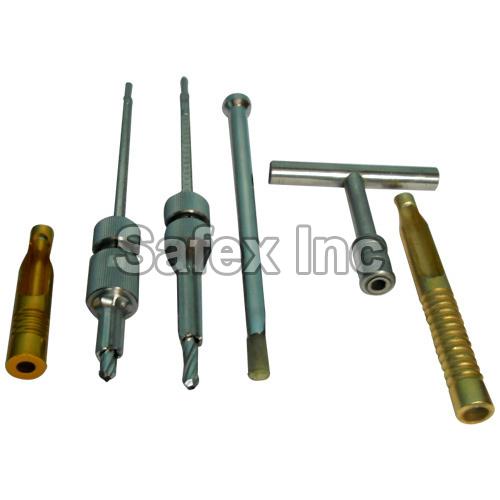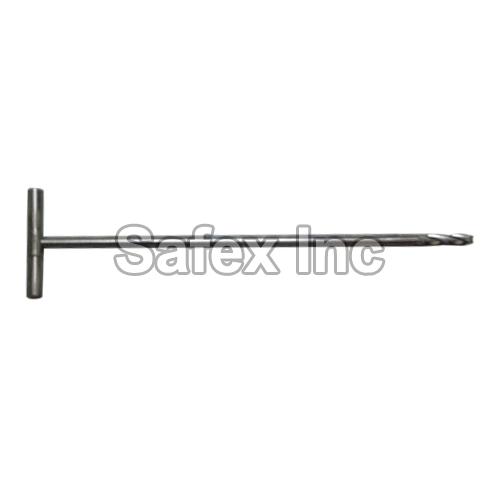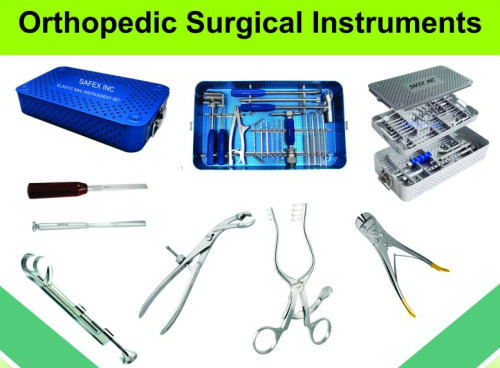Roshanara Road, Delhi
- GST NO. : 07AABFZ1852E1ZA
Orthopedic Instruments
Leading Manufacturers, Exporters, Wholesaler, Retailer and Trader of bone drills, dhs instrument set and Orthopedic Reamers from Delhi.
| Business Type | Manufacturer, Exporter, Supplier, Retailer, Wholesaler, Trader, Distributor, Importer, Buying House |
| Driven Type | Electric |
| Color | Black |
| Condition | New |
| Automatic Grade | Manual, Semi Automatic |
| Application | Implant Surgery, Surgical Use |
| Voltage | 220V |
| Type | Bone Drills, Portable |
| Country of Origin | India |
| Packaging | Poly Pack |
| Material | Steel |
| Warranty | 1 Year |
| Varialbe Speed | Low-noise |
| Product Code | SAFEX-ORTHO108 |
| Port | New Delhi |
| Payment Terms | L/C, D/A, D/P, T/T, Western Union |
| Delivery Time | Quick |
Preferred Buyer From
| Location | Worldwide |
SAFEX INCs Bone drills are surgical instruments used in orthopedic and other medical procedures to create holes or openings in bone tissue. These drills are designed to cut bone with precision, allowing surgeons to perform various procedures, such as inserting screws, pins, or implants, and to shape or remove bone tissue when necessary.
| Business Type | Manufacturer, Exporter, Supplier, Retailer, Wholesaler, Trader, Distributor, Importer, Buying House |
| Material | Steel |
| Color | Silver |
| Application | Hospital, Orthopedic Trauma Surgery |
| Length | 25-30mm |
| Feature | Corrosion Resistant, Excellent Finish, Fine Finish |
| Packaging Type | Plastic Pouch |
| Type | Dhs Set |
| Country of Origin | India |
| Port | New Delhi |
| Payment Terms | L/C, D/A, D/P, T/T, Western Union |
| Delivery Time | Quick Delivery |
Preferred Buyer From
| Location | Worldwide |
SAFEX INCs Dynamic Hip Screw (DHS) is an orthopedic implant used in the surgical treatment of certain hip fractures, particularly fractures of the proximal femur. The DHS system includes a variety of specialized instruments and implants designed to facilitate the placement of the hip screw and achieve stable fixation of the fractured bone. The DHS implant is often used in cases of intertrochanteric and subtrochanteric fractures.
A typical DHS instrument set may include the following components:
-
DHS Plate: The dynamic hip screw plate is a large, angled plate that is affixed to the lateral aspect of the proximal femur. It usually has multiple holes to allow for fixation with screws.
-
DHS Screw: The dynamic hip screw itself is a large screw that is inserted into the femoral head, passing through the plate. The screw has a dynamic feature, allowing controlled sliding of the femoral head along the screw, which aids in load-sharing and promotes healing.
-
Guide Wire: A guide wire is used to guide the placement of the hip screw. It is typically inserted into the femoral head and neck under fluoroscopic guidance before the actual screw is introduced.
-
Drill Bits: Various drill bits are used to create holes in the bone for the insertion of screws. These may include cortical and cancellous drill bits.
-
Depth Gauge: A depth gauge is used to measure the depth of the drill holes, ensuring proper placement of the screws.
-
Tap: A tap is used to create threads in the bone before inserting the actual screws.
-
Lag Screw: In some cases, a lag screw may be used instead of or in addition to the dynamic hip screw. The lag screw compresses the fracture surfaces, promoting stability.
-
Instrumentation for Plate and Screw Placement: This includes instruments like screwdrivers, screw holders, and plate benders to facilitate the correct positioning and fixation of the plate and screws.
It's important to note that the specific contents of a DHS instrument set can vary between manufacturers, and surgeons may choose instruments based on their preferences and the patient's specific anatomy.
| Business Type | Manufacturer, Exporter, Supplier, Retailer, Wholesaler, Trader, Distributor, Importer, Buying House |
| Brand Name | SAFEX INCs |
| Material | Stainless Steel |
| Surface Finishing | Coated |
| Condition | New |
| Automation Grade | Manual |
| Uses | Surgical |
| Feature | Sharp Edge, Rust Proof |
| Thickness | 0-10mm |
| Country of Origin | India |
| Diameter | 1mm to 20mm |
| Size | Available in Different Sizes |
| Port | New Delhi |
| Payment Terms | L/C, D/A, D/P, T/T, Western Union |
| Delivery Time | Quick |
Preferred Buyer From
| Location | Worldwide |
SAFEX INCs Orthopedic reamers are surgical instruments used in orthopedic procedures to prepare and shape bone for the placement of implants, such as screws, nails, or prosthetic components. Reaming is the process of enlarging a bone canal or cavity to achieve a desired size and shape for implantation. Orthopedic reamers come in various types and sizes, and they play a crucial role in procedures like joint replacements, fracture fixation, and other orthopedic surgeries.
Here are some common types of orthopedic reamers:
-
Reaming Systems:
- Orthopedic Reaming Systems: These systems typically include a range of reamers in various sizes, along with compatible handles and attachments for use with power tools or manually.
-
Cannulated Reamers:
- Cannulated Reamers: These reamers have a hollow center, allowing them to be used over a guide wire. Cannulated reamers are often used in procedures that require precise placement, such as intramedullary nailing.
-
Flexible Reamers:
- Flexible Reamers: Designed to navigate through curves or tight spaces, these reamers are useful in anatomical areas where flexibility is required.
-
Universal Reamers:
- Universal Reamers: These are versatile reamers designed for general use across a variety of orthopedic procedures. They may be adjustable or available in a range of sizes.
-
Antegrade and Retrograde Reamers:
- Antegrade Reamers: Used in procedures where reaming is performed in the same direction as the normal anatomical alignment.
- Retrograde Reamers: Used when reaming is done in the opposite direction to the normal anatomical alignment.
-
Reamers for Specific Procedures:
- Hip Reamers: Designed for use in hip arthroplasty procedures, including total hip replacement.
- Knee Reamers: Used in knee arthroplasty procedures, including total knee replacement.
- Shoulder Reamers: Designed for use in shoulder arthroplasty procedures.
-
Pedicle Reamers:
- Pedicle Reamers: Specifically designed for use in spinal surgeries, particularly in the preparation of the vertebral pedicles for the placement of pedicle screws.
-
Arthroscopic Reamers:
- Arthroscopic Reamers: Used in arthroscopic procedures to prepare bone surfaces or remove damaged tissue within a joint.
It's important to note that the use of orthopedic reamers requires specialized training and expertise. Surgeons carefully select the appropriate reamers based on the specific surgical procedure, patient anatomy, and the type of implant being used. The goal is to achieve proper sizing and preparation of the bone to ensure optimal implant fit and stability.
As with any surgical instrument, orthopedic reamers are subject to strict sterilization protocols to maintain aseptic conditions in the operating room. These instruments play a critical role in achieving successful outcomes in orthopedic surgeries





